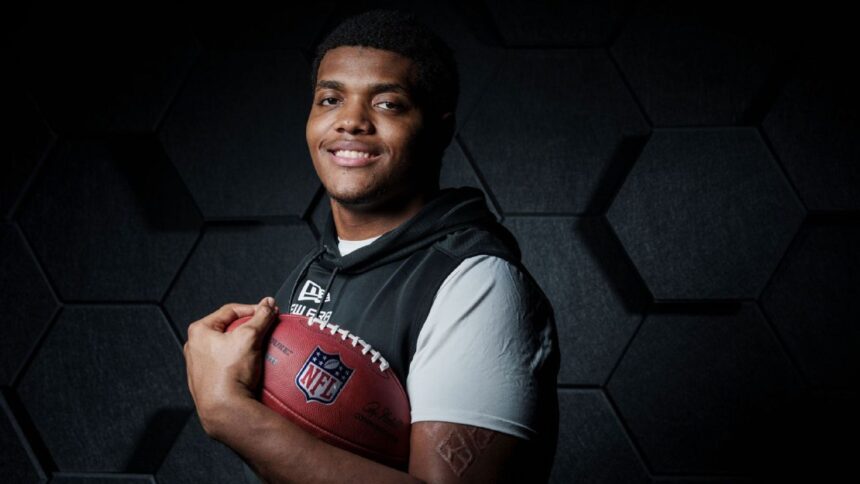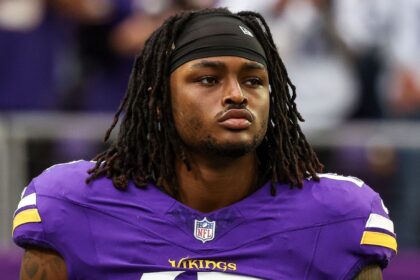Carson Vinson: From Historically Black University to the NFL
There was a time when the then offensive line coach of Alabama A&M, Markus Lawrence, held his breath every time Carson Vinson knocked on his door. Lawrence feared that, at some point, the talented 6-foot-7-inch, 314-pound offensive tackle would tell him that he would enter the transfer portal. However, despite the trend of promising players going to larger universities and better salaries, Vinson remained in Huntsville, Alabama, to start for all four seasons and decided to take the road less traveled to the NFL. This year, he was the only player from a historically black college to be selected in the NFL draft, when the Baltimore Ravens picked him in the fifth round.Vinson is proud to come from an HBCU university, but says there is no pride in being the first player from an HBCU drafted since 2023. He insists that the NFL overlooked many players this year from the 21 HBCU schools that compete at the FCS level. Vinson’s hope is that his success will pave the way for more HBCU players to reach the NFL. He doesn’t want players to transfer to renowned programs if that’s not what they really want. The key for Vinson was to capitalize on opportunities against the best competition. After being the first HBCU player invited to the Senior Bowl in two years, Vinson impressed in individual drills in January, including a dominant play against Bengals’ first-round pick Shemar Stewart. As the only HBCU player at the NFL combine in February, he finished among the top 15 offensive linemen in the 40-yard dash (5.2 seconds), the broad jump (9 feet, 3 inches), and the three-cone drill (7.51 seconds).“He could have left us and chased the money,” said Lawrence, who is now the offensive line coach at South Carolina State. “Instead, he chased commitment and loyalty.”
Markus Lawrence
In the last five NFL drafts, Vinson is only the second player from an HBCU school to be selected in the first five rounds. The other player was South Carolina State cornerback Cobie Durant, who was chosen in the fourth round by the Los Angeles Rams in 2022. Vinson, a player with a great future in the NFL, has come a long way since he arrived at Alabama A&M in 2020 as a two-star recruit. Coach Lawrence wasn’t a big fan of Carson at first, but everything changed in the first college practice, where Vinson proved his worth. Vinson has the size and build of an NFL left tackle. In his third year, Vinson showed he could take on FBS pass rushers in the 47-13 loss to Vanderbilt by Alabama A&M. It was then that Vinson had the opportunity to return home to North Carolina. Alabama A&M’s coaching staff wasn’t surprised that Vinson decided to stay. He’s always had a different approach. Vinson arrived at the games with a chessboard and played with his teammates in the locker room. Nobody at Alabama A&M ever beat him, according to Vinson. The Ravens’ general manager, Eric DeCosta, realized when watching Vinson’s tape that he had tremendous size and strength. He just didn’t realize how much strength. In his final season at Alabama A&M, Vinson was named Offensive Lineman of the Year by the Southwestern Athletic Conference. He totaled 61 tackles and allowed one sack, which came against Auburn in the season opener. Ravens offensive line coach George Warhop thought Vinson’s college tape “was really acceptable.” Then, Vinson became one of Warhop’s favorite prospects because of his performance at the Senior Bowl. Ravens coach John Harbaugh said Warhop was “beating the drum for Carson Vinson” all week leading up to the draft. When Baltimore made the decision to pick Vinson with the 141st overall pick, DeCosta called Vinson to give him the good news. Soon, the phone was handed to Warhop. Warhop has kept his promise of tough love. From rookie minicamp in May to the mandatory seven weeks later, Warhop could be heard yelling corrections at Vinson about his feet, hand placement, and other technique issues, and it usually involved colorful four-letter words. If the Ravens stay healthy, they won’t need Vinson to play immediately. Baltimore re-signed left tackle Ronnie Stanley in free agency and returned second-year right tackle Roger Rosengarten. The Ravens have a history of developing offensive linemen from Day 3. In the previous twelve drafts, Baltimore has had seven offensive linemen who eventually became starters after being selected in the fourth round or later: Ryan Jensen (2013), Rick Wagner (2013), Alex Lewis (2016), Jermaine Eluemunor (2017), Bradley Bozeman (2018), Ben Powers (2019), and Ben Bredeson (2020). If Vinson fulfills his dream of becoming a starter in the NFL, he will not forget his HBCU roots. He remembers how Alabama A&M alumni, such as Hall of Fame wide receiver John Stallworth and five-time Pro Bowl defensive end Robert Mathis, impacted him. Vinson added: “So it’s really important not just to give money, anyone can give a check, but it’s really important to be there and be practical.”“Being from an HBCU is something very special,” Vinson said. “We have our rivalries, but after we get through them, we’re all one big family.”
Carson Vinson











